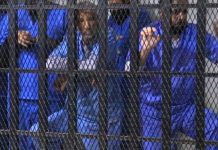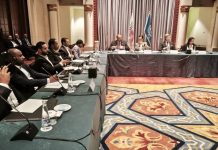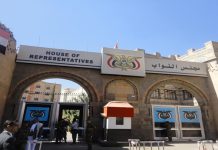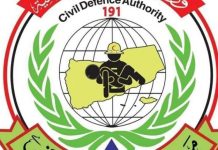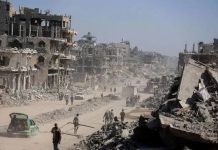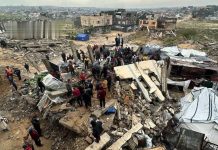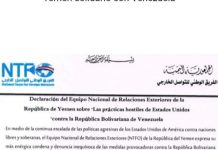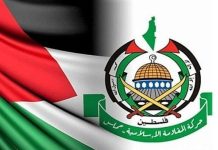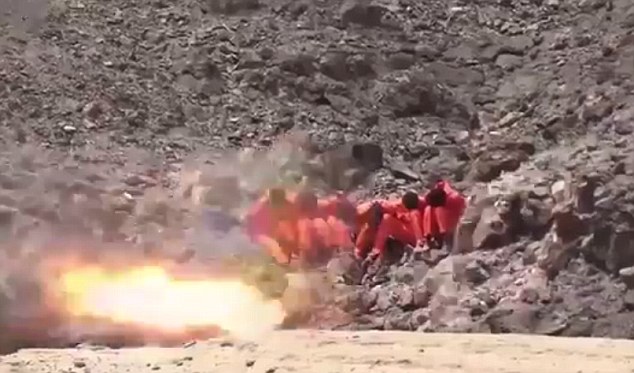Al- Thawra Net
Yemeni army spokesman Brigadier General Yahya Sare’e has on Friday revealed the details and scenes of Operation Al-Bunyan Al-Marsous and the strikes on military and economic targets deep inside Saudi Arabia.
In a press conference held in Sana’a on Friday evening, the military spokesman confirmed that the Yemeni armed forces are “ready to fight a long battle that does not end, because we are in the position of truth defending our country.”
“The Saudi-led coalition has to expect more strikes and operations as long as it the aggression and siege continue,” he added.
He pointed out at the press conference the number of air force operations conducted on internal and external targets exceeded 41, while and the number of missile force operations reached to 21 strikes. A total of 26 operations hit the airports of Abha, Jizan, Najran, Khamis Mushit base, Aramco and sensitive targets deep inside in Saudi Arabia. These strikes were carried out between the 25th and 30th of this month.
He explained that the Nihm district has witnessed military operations escalation by the Saudi-led aggression and its mercenaries.
Sare’e also said the enemy had pushed “various formations of its forces into the Area of Nihm over the past years, to the extent that the area had 17 military brigades and a number of battalions and transported various military equipment of heavy, medium and light weapons.”
An entire military region belonging to the enemy was stationed in the area, as well as special forces from the countries of aggression responsible for the operation of fire and intelligence support.
Brigadier General Yahya Sare’e reviewed the map of the deployment of enemy forces prior to the operation and the hostile military brigades.
“Despite this great military force, the enemy was depending on its warplanes during the past years. Nihm district has been subjected to thousands of raids. Its residents gave dozens of martyrs, men, women and children, in addition to the deliberate destruction of their property by the aggression and its tools,” he said.
The spokesman stressed that the Nihm’s mountainous areas and its topography is complex, which meant that the Yemeni troops during the first days of the confrontations were pushed by specialized units to reinforce the combat position.
“After the successful response to the aggression forces’ attack, our forces began to carry out a military offensive that expanded as the enemy’s frontlines collapsed and our forces advanced towards strategic heights,” he added.
“Our forces’ attacks started from four main directions,” he said.
Sare’e pointed out that the Yemeni forces were keen to maintain the siege through a comprehensive encirclement process. In addition, [we put] military pressure on all enemy positions and camps, in order to force them to surrender while taking care of the lives of Yemenis there, especially those who have shown their willingness to leave the battle.”
The general stressed that” “our forces succeeded in dealing with enemy forces through direct engagement, after which our forces gave them [the Saudis] the opportunity to leave and escape, so that our forces could continue to advance beyond the Nihm district.”
“Thousands of the mercenaries were able to leave the area of operations during the first days, and our forces dealt only with those mercenaries who continued to resist. Our forces were able to cut off the supply lines of the enemy forces, taking advantage of their positions near Ma’rib province.”
The military spokesman indicated that the invaders launched more than 250 airstrikes targeting the army and Popular Committees, but without halting the Yemeni offensive.
He stressed that units of the Air Defence Forces participated in the operation, with the Fater 1 system playing an important role in disrupting the planes and hindering them when they carried out raids.
He pointed out that after the activation of the air defence system, the warplanes resorted to raids from high altitudes so as not to be exposed to the missiles of Fater system.
“The air defence system has successfully carried out more than 25 response operations,” he said.
He confirmed that “the continuation of the aggression raids prompted our forces to respond decisively, and the leadership’s directives were clear in ordering strikes against Saudi military installations and bases.”
Yahya Sare’e further confirmed the arrival of Yemeni forces in Jawf junction and their advance into the province, joining the advancing forces in the same area and starting another offensive to liberate areas in Ma’rib and Jawf provinces.
“During the first days of the operation, our forces liberated an area of 800 square kilometers, mostly strategic sites and important heights, before, thanks to God, they were able to liberate areas in Ma’rib and Jawf provinces, in addition to an area of 2,500 square kilometers in Sana’a,” he said.
The Brigadier General reviewed a map of the area of operations after the advance of Yemeni forces and the areas liberated during the first week of the operation, the areas being liberated later, and the areas of ongoing clashes such as around the city of Al-Hazm.
“The position in favour of the nation held by the Ma’rib tribes, as well as the Jawf tribes, and before that the tribes of Nihm, have contributed greatly to the liberation of the directorates of Nihm in Sana’a, Masjzar in Ma’rib, Al-Motun, Barash and Safar areas in Jawf, as well as large parts of the directorates of Madgha’al in Ma’rib, Ghail and Al-Khalq in Jawf,” he said.
“The Directorate of Hazam, which includes the capital of Jawf province, has become an area of confrontations, as well as some parts of the al-Ghail district of Marib and Madghal in Ma’rib,” he said.
The spokesman stressed that “our forces have reinforced their advanced positions near the city of Ma’rib and seized large military equipment, including heavy and medium weapons.”
The spokesman reviewed the preliminary statistics of the enemy’s losses, which amounted to more than 3,500 dead, injured and captured, including 1,500 enemies killed. Most of the bodies are still in the area of operations, and among the dead a large number of leaders of different levels.
The number of injured reached 1,830 according to intelligence sources, and there are hundreds who have been taken prisoners.


